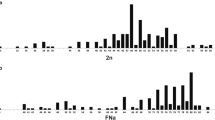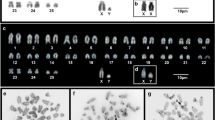Abstract
Early taxonomic investigations associated the genus Scotinomys with South American akodontine rodents, but more recent morphological analyses based in large part on the glans penis have linked brown mice with North American peromyscines, specifically the genus Baiomys. Differentially stained chromosomal preparations of S. xerampelinus were compared with other cricetine taxa. Chromosomally, golden mice (Ochrotomys) were found to be most similar to Scotinomys, this association based on two apparent synapomorphic G-banded chromosomes. The majority of banded chromosomes possessed by Scotinomys were found to be either uniquely derived or to appear unaltered, and therefore presumably ancestral, when compared to the G-band patterns of other cricetids. These results fail to support the morphological hypotheses that closely unite Scotinomys with Baiomys, and instead support a hypothesis that treats Scotinomys, Ochrotomys, and perhaps Baiomys as a rather loosely associated assemblage of genera that are phylogenetically intermediate between the relatively complex pene, primarily South American cricetine rodents and the more simple pene North American neotomine-peromyscines.
Similar content being viewed by others
References
Allen, J. A., 1904. Mammals from southern Mexico and Central and South America. Bull. Mus. Am. Nat. Hist. 20: 29–80.
Bangs, O., 1902. Chiriqui Mammalia. Bull. Mus. Comp. Zool. 39: 17–51.
Baker, R. J., Barnett, R. K. & Greenbaum, I. F., 1979. Chromosomal evolution in grasshopper mice (Onychomys: Cricetidae). J. Mammal. 60: 297–306.
Brown, M., 1980. Trypsin, G-bands using Wright's Sect 4, pp 47–48. In. The Association of Cytogenetic Technologists Cytogenetics laboratory manual (M.S.Hack & H. J.Lawce, eds). Univ. Assoc. of Cytogenetic Technologists, University of California, San Francisco.
Carleton, M. D., 1980. Phylogenetic relationships in neotomineperomyscine rodents (Muroidea) and a reappraisal of the dichotomy within the New World cricetinae. Misc. Publs Mus. Zool. Univ. Mich. 157: 1–146.
Carleton, M. D., Hooper, E. T. & Honacki, J., 1975. Karyotypes and accessory reproductive glands in the rodent genus Scotinomys. J. Mammal. 56: 916–921.
Committee for Standardization of Chromosomes of Peromyscus, 1977. Standardized karyotype of deer mice, Peromyscus (Rodentia), Cytogenet. Cell Genet. 19: 38–43.
Engstrom, M. D. & Bickham, J. W., 1982. Chromosome banding and phylogenetics of the golden mouse, Ochrotomys nuttalli. Genetica 59: 119–126.
Engstrom, M. D. & Bickham, J. W., 1983. Karyotype of Nelsonia neotomodon, with notes on the primitive karyotype of peromyscine rodents. J. Mammal. 64: 685–688.
Greenbaum, I. F. & Baker, R. J., 1978. Determination of the primitive karyotype for Peromyscus. J. Mammal. 59: 820–834.
Greenbaum, I. F., Baker, R. J. & Bowers, J. H., 1978a. Chromosomal homology and divergence between sibling species of deer mice: Peromyscus maniculatus and P. melanotis (Rodentia, Cricetidae). Evolution 32: 334–341.
Greenbaum, I. F., Baker, R. J. & Ramsey, P. R., 1978b. Chromosomal evolution and the mode of speciation in three species of Peromyscus. Evolution 32: 646–654.
Hershkovitz, P., 1966. Mice, land bridges and Latin American faunal interchange. In: Ectoparasites of Panama (R.Wetzel & V. J.Tipton, eds): pp. 745–747. Field Mus. Nat. Hist. Chicago.
Hershkovitz, P., 1972. The recent mammals of the Neotropical region: a zoogeographic and ecological review. In: Evolution, mammals, and southern continents (A.Keast, F. C.Erk & B.Glass, eds): pp. 311–431. State Univ. New York Press, Albany.
Hooper, E. T., 1959. The glans penis in five genera of cricetid rodents. Occ. Pap. Mus. Zool. Univ. Mich. 613: 1–10.
Hooper, E. T., 1960. The glans penis in Neotoma (Rodentia) and allied genera. Occ. Pap. Mus. Zool Univ. Mich. 618: 1–21.
Hooper, E. T., 1972. A synopsis of the rodent genus Scotinomys. Occ. Pap. Mus. Zool. Univ. Mich. 665: 1–32.
Hooper, E. T. & Musser, G. G., 1964. The glans penis in Neotropical cricetines (Family Muridae) with comments on classification of muroid rodents. Misc. Publs Mus. Zool. Univ. Mich. 123: 1–57.
Koop, B. F., Baker, R. J., Haiduk, M. W. & Engstrom, M. D., 1983. Cladistical analysis of primitive G-band sequences for the karyotype of the ancestor of the Muridae-Cricetidae complex of rodents. Genetica, in press.
Lee, M. R. & Elder, F. F. B., 1980. Yeast stimulation of bone marrow mitosis for cytogenetic investigations. Cytogenet. Cell Genet. 26: 36–40.
Mascarello, J. T., Stock, A. D. & Pathak, S., 1974. Conservatism in the arrangement of genetic material in rodents. J. Mammal. 55: 695–704.
Pathak, S., Hsu, T. C., Shirley, L. & HelmII, J. D., 1973. Chromosome homology in the climing rats, genus Tylomys (Rodentia: Cricetidae). Chromosoma 42: 215–228.
Patton, J. L., 1967. Chromosome studies of certain pocket mice, genus Perognathus (Rodentia: Heteromyidae). J. Mammal. 48: 629–639.
Reig, O. A., 1980. A new fossil genus of South American cridetid rodents allied to Weidomys, with an assessment of the Sigmodontinae. J. Zool. Res. 192: 257–281.
Robbins, L. W. & Baker, R. J., 1980. G- and C-band studies on the primitive karyotype for Reithrodontomys. J. Mammal. 61: 708–714.
Robbins, L. W. & Baker, R. J., 1981. An assessment of the nature of chromosomal rearrangements in eighteen species of Peromyscus (Rodentia: Cricetidae). Cytogenet. Cell Genet. 31: 194–202.
Rogers, D. S., 1983. Phytogenetic affinities of Peromyscus (Megadontomys) thomasi: Evidence from differentially stained chromosomes. J. Mammal. 64: 617–622.
Rogers, D. S., Greenbaum, I. F., Gunn, S. G. & Engstrom, M. D., 1984. Cytosystematic value of chromosomal inversion data in the genus Peromyscus (Rodentia: Cricetidae). J. Mammal. 65: (in press).
Stefos, K. & Arrighi, F. E., 1971. Heterochromatic nature of W chromosomes in birds. Expl Cell Res. 68: 228–231.
Stock, A. D. & Hsu, T. C., 1973. Evolutionary conservatism in arrangement of genetic material. Chromosoma 43: 211–224.
Thomas, O., 1913. New forms of Akodon and Phyllotis, and a new genus for ‘Akodon’ teguina. Ann. Mag. Nat. Hist. 11: 404–409.
Vorontsov, N. N., 1959. The system of hamster (Cricetinae) in the sphere of the world fauna and their phylogenetic relations. Bull. Mosk. Obsh. Ispyt. Prirody. Biol. Soc. 64: 134–137.
Yates, T. L., Baker, R. J. & Barnett, R. K. 1979. Phylogenetic analysis of karyological variation in three genera of peromyscine rodents. Syst. Zool. 28: 40–48.
Author information
Authors and Affiliations
Rights and permissions
About this article
Cite this article
Rogers, D.S., Heske, E.J. Chromosomal evolution of the brown mice, genus Scotinomys (Rodentia: Cricetidae). Genetica 63, 221–228 (1984). https://doi.org/10.1007/BF00128416
Received:
Accepted:
Issue Date:
DOI: https://doi.org/10.1007/BF00128416




